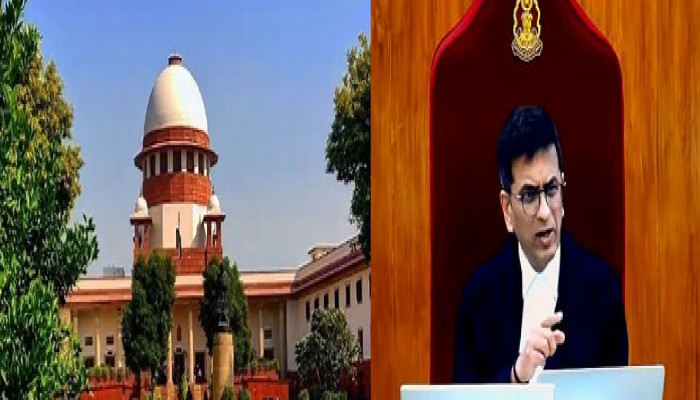SC redefines ‘summer vacation’ as ‘partial working days’
- In Reports
- 03:55 PM, Nov 08, 2024
- Myind Staff
In response to criticism for being on "vacation" for seven weeks in the summer, the Supreme Court, with approval from the President of India, has updated its rules. It will now use the term "partial working days" instead of "summer vacation," to emphasise that some benches continue to work even during the summer break.
This change was made in response to public and governmental perceptions that the court was completely dormant during its seven-week hiatus from late May to mid-July. It was announced in a Gazette notification on Thursday. The term "summer vacation" will be replaced by this new one on the Supreme Court calendar starting in 2025. The Supreme Court has also replaced the phrase "Vacation Judge" with the word "Judge," emphasising that a portion of the court still operates during breaks.
In response to criticism for taking a seven-week summer break, the Supreme Court has changed its rules, with the President of India’s approval, to replace the term "summer vacation" with "partial working days." This change aims to emphasise that some benches still function during the court's annual summer break. The court's move to reinterpret its vacation time coincides with continuous criticism of judicial work hours and vacations.
In a March 2023 media event, Chief Justice of India Dhananjaya Y. Chandrachud addressed this criticism head-on, emphasising that Indian Supreme Court judges sit for 200 days (roughly six and a half months) annually, while the US, Australian, and UK Supreme Courts only sit for 80 days, less than 100 days, and 145 days, respectively. “What people don’t know is that most of the time in the so-called vacation is spent on preparing judgments which you have kept in reserve because you have just had no time during the week when you are working seven days just trying to keep ahead of the curve to deal with your cases,” the CJI said then.
In May, Justices Dipankar Datta and Satish Chandra Sharma addressed concerns about the perception that judges take lengthy vacations. They explained that while the judiciary does have scheduled breaks, judges remain busy preparing cases and are available to handle urgent matters. This discussion, on May 22, was partly in response to comments from Sanjeev Sanyal, an economic advisor to Prime Minister Modi, who suggested that these "long vacations" contribute to delays in the justice system. Justice Datta clarified that delays often arise because government agencies miss deadlines for submitting appeals and petitions.
A bench presided over by Justice BR Gavai had declared earlier in the same month, stating “People who criticise us for having long vacations do not know that we do not have a holiday on Saturdays and Sundays. These days are filled with conferences and other assignments...We also get the time to write long judgments during vacations.” In August 2023, a Parliamentary panel suggested ending long vacations for the judiciary, highlighting that they contribute to the public’s concerns about delays in the legal system and the large number of pending cases. While the panel agreed that vacations are not the only reason for case backlogs, it considered these breaks to be a "colonial legacy" that adds inconvenience for people waiting on court decisions.
In 2009, the Law Commission recommended that court vacations be shortened by 10 to 15 days and the retirement age for judges increased by three years. In 2014, then Chief Justice R.M. Lodha revised the Supreme Court rules, reducing summer vacation by about three weeks. However, the retirement age stayed at 65, and the number of Supreme Court judges increased by only three. Back in 1987, the Law Commission advised there should be 107 judges per million people by 2000. However, by 2022, the actual number was only 21 judges per million.
The debate over vacations in the top court revolves around three main points: the number of judges available, the time needed to write detailed judgments, and how the court’s schedule compares with top courts in other countries. In 1950, the Supreme Court had eight judges and dealt with 1,215 cases, resolving 525 of them, which meant each judge handled around 75 cases on average. Today, the court has expanded to 34 judges, but the rise in cases has far surpassed this increase. By 2019, 43,613 cases were filed, with the court deciding on 41,100, leading to an average of around 1,400 cases per judge.
Each bench, made up of two or three judges, handles a heavy workload, often hearing 50-60 cases each day. This leaves judges with limited time to thoroughly review complex legal and constitutional questions, which require careful interpretation. Judges have stated that during vacations, they dedicate significant time to researching, analysing, and drafting judgments. This process is essential for delivering justice clearly and accurately. During breaks, the court registry and staff operate like a regular government office, and judges take turns sitting on vacation benches. These benches, active five days a week, handle urgent matters, new appeals and some older cases where lawyers agree to argue during the break.
Looking at the Supreme Court of India’s schedule in comparison to other top courts globally helps provide context. The Supreme Court of India sits about 200 days each year, whereas the U.S. Supreme Court sits around 80 days. Australia’s highest court meets for about two weeks each month and takes two months off, totaling less than 100 days annually. Similarly, Singapore’s Supreme Court meets for approximately 145 days a year. The UK Supreme Court is one of the few that matches India’s in number of working days. Unlike many apex courts, which mainly handle constitutional cases, the Indian Supreme Court also serves as the final court of appeals, significantly increasing its workload.







Comments